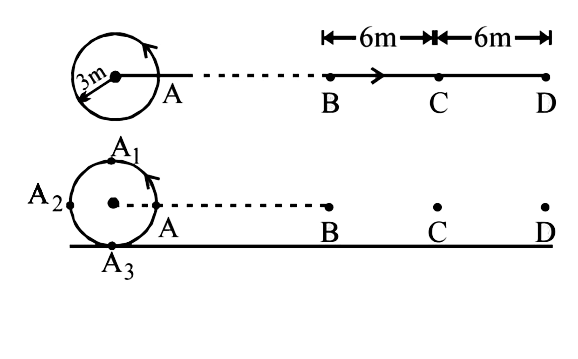A source of sound emits sound waves at frequency f0. It is moving towards an observer with fixed speed vs(vs<v where v is the speed in air). If the observer were to move towards the source with speed v0 one of the following two graphs (A and B) will give the correct variation of the frequency f heard by the observer as v0 is changed,
_E01_169_Q01.png)
The variation of f with v0 is given correctly by :-Solution in Gujrati
graph A with slope =f0(v+vs)
graph B with slope =f0(v−vs)
graph B with slope =f0(v+vs)
graph A with slope =f0(v−vs)
The correct Answer is:D
Apprent frequency
f=f0(V+V0V−VS)=f0VV−VS+f0V0(V−VS)
Topper's Solved these Questions
- WAVES AND OSCILLATIONSBOOK - ALLEN CHAPTER - WAVES AND OSCILLATIONSEXERCISE - Part-1(Exercise-05)[B]
42 Videos
- WAVES AND OSCILLATIONSBOOK - ALLEN CHAPTER - WAVES AND OSCILLATIONSEXERCISE - Part-1(Exercise-04)[B]
13 Videos
- SEMICONDUCTORSBOOK - ALLEN CHAPTER - SEMICONDUCTORSEXERCISE - Part-3(Exercise-4)
50 Videos
Similar Questions
A string of length 0.4m and mass 10−2kg is clamped at one end . The tension in the string is 1.6N. The identical wave pulses are generated at the free end after regular interval of time , Δt . The minimum value of Δt , so that a constructive interference takes place between successive pulses is
View SolutionA source of sound is moving along a circular orbit of radius 3meter with an angular velocity of 10rad/s. A sound detector located far away from the source is executing linear simple harmonic motion along the line BD with an amplitude BC=CD=6meters. The frequency of oscillation of the detector is 5π per second. The source is at the point A when the detector is at the point B. If the source emits a continuous sound wave of frequency 340Hz, Find the maximum and the minimum frequencies recorded by the detector.

View SolutionAt absolute zero temperature Si acts as ……..
View SolutionThe source (S) of sound is moving constant velocity v_(0) as shown in diagram. An observer O listens to the sound emmited by the source. The observed frequency of the sound
View SolutionThe source producing sound and an observer both are moving along the direction of propagation of sound waves. If the respective velocities of sound, source and an observer are v,vs and v0, then the apparent frequency heard by the observer will be (n = frequency of sound)
View SolutionA source and an observer are moving towards each other with a speed equal to v2 where v is the speed of sound. The source is emitting sound of frequency n . The frequency heard by the observer will be
View SolutionA source emitting sound of frequency 1000 Hz is moving towards an observer at speed v_s=0.90 v ,(where v is the velocity of sound) . What frequency will be heard by the observer ?
View Solutionthe frequency changes by 10 % as the source approaches a stationary observer with constant speed v_(s) . What would be the percentage change in frequency as the sources reaccedes the observer with the same speed ? Given , that v_(s)lt lt v (v= speed pf sound in air )
View SolutionTwo sources of sound moving with same speed v and emitting frequency of 1400 Hz are moving such that one source s_1 is moving towards the observer and s_2 is moving away from observer. If observer hears beat frequency of 2 Hz. Then find the speed of source. Given v_(sound) gt gt v_(source) and v_(sound) = 350m/s
View Solutionएक ध्वनि स्रोत जिसकी आवृति f है, स्थिर है। एक श्रोता v0 वेग से - (i) स्रोत की ओर, (ii) स्रोत से दूर गतिमान है। श्रोता द्वारा सुनी गयी आभासी आवृति का सूत्र लिखिये । (वायु में ध्वनि की चाल v है )
View Solutionf आवृति का ध्वनि स्रोत vs वेग से स्थिर दीवार की ओर जा रहा है। दीवार द्वारा परावर्तित ध्वनि की आवृति f' का मन लिखिये। (वायु में ध्वनि की चाल v है )
View SolutionVelocity of sound is v. Source and observer move towards each other with velocities V_(s) and V_(0) respectively. Wind is blowing with a velocity v_(m) in the direction opposite to the propagation of sound, n is the frequency of the sound. The apparent frequency of the sound heard by the observer is :-
View SolutionConsider the droppler effect in two cases. In the first case an observer moves towards a stationary sound-source, with a speed V1. In the second case, the observer is at rest, and the source moves towards the observer with the same speed V1. Then the frequency heard by the observer
View SolutionA car moves towards a hill with speed v_(c) .It blows a horn of frequency f which is heard by an observer following the car with speed s .The speed of sound in air is v . find frequency heard by the observer.
View Solutionthe frequency changes by 10 % as the source approaches a stationary observer with constant speed vs. What would be the percentage change in frequency as the sources reaccedes the observer with the same speed ? Given , that vs<<v(v= speed pf sound in air )
View SolutionThe frequency changes by 10% as a sound source approaches a stationary observer with constant speed vs. What would be the percentage change in frequency as the source recedes the observer with the same speed. Given that vs<v (v = speed of sound in air)
View Solution
